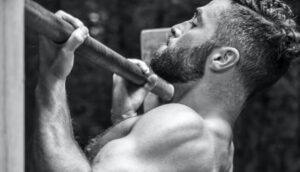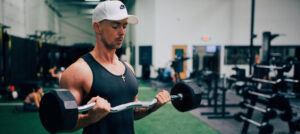The biceps might not be the biggest or the strongest muscle in your body, but it is definitely a muscle a lot of bodybuilders desire no matter what their experience.
There is no special way to get huge biceps despite some articles promising to ‘grow an inch in 24 hours’, it is just never going to happen. Gaining muscle on any muscle group is not easy and takes a lot of hard work, so I am going to help you today by telling you how to build huge biceps.
The bicep muscles are a very easy muscle to target by using isolation exercises but if you want to see big bicep gains, compound exercises are also important.
In this article I am going to show you the best compound and isolation exercises for gaining maximum strength and size in your biceps and also give you my personal bicep training plan that I have been using for many years.
Before this I am going to show you the different muscles in the biceps, so you know exactly where each exercise is targeting, and tell you the function of each muscle.
Anatomy of the Biceps Muscle
The biceps is a large muscle situated on the front of the upper arm between the shoulder and the elbow, with its main function being flexion and supination of the forearm.
The biceps muscle is made up of two heads. At each end are connective tissues called tendons that anchor the muscles to bone.
- The long head originates from a cavity in the scapula called the glenoid. It passes through the shoulder joint to the upper arm through a groove in the humerus (the large bone of the upper arm).
- The short head originates from a projection on the scapula called the coracoid and runs alongside the long head on the inside of the arm.
Compound vs Isolation Exercises
Compound exercises are exercises that work multiple muscle groups at the same time, which makes them great exercises for building strength and muscle mass.
They are also very convenient, as by working multiple muscles at once, it can save you a lot of time when working out, whilst at the same time burning a lot more calories than isolation exercises, as they activate more muscle cells.
Isolation exercises are important exercises when correcting muscle imbalances as they directly target and strengthen a certain muscle.
As they target certain muscles it also makes them very useful to target a certain muscle, if you feel like a certain part of your body is falling behind the rest of your body.
Both compound and isolation exercises are very important exercises in a workout routine, and if you want to build a nice physique, a balance of both compound and isolation exercises is essential.
Powering Up with Compound Moves
The majority of bicep exercises that we use are isolation exercise as compound exercises are usually associated with larger muscle groups as they work and stimulate multiple muscles. Despite this there are still some compound exercises that you can use to build strength and muscle mass in your biceps.
The best compound exercises for biceps are:
Chin-ups

A lot of people think that chin-ups are a back exercise. Although it does work back muscles, it is also a very good compound exercise that we can use to build our bicep muscles, as when we use a closer grip, and use an underhand grip, we put a lot more tension on the biceps.
The primary muscles used are:
- Bicep
- Brachialis
- Latissimus Dorsi
The secondary muscles used are:
- Pectoral Major
- Posterior (rear) Deltoids
- Trapezius
- Teres Major
- Triceps
How to perform chin-up…
- Grab the bar with an underhand grip, with your arms straight and about shoulder width apart.
- Pull yourself straight up, until your chest is at the bar.
- Lower yourself back down in a controlled motion, back to starting position.
Chin-ups are one of the best bodyweight exercises to build strength in your arms, shoulders and core, due to the large amounts of muscles used to perform them.
Hammer Row
Despite mainly targeting the muscles of your upper and middle back, the hammer row is also a good compound exercise to build strength and muscle mass in your biceps.
The primary muscles used are:
- Latissimus Dorsi
- Rhomboids
- Rear Deltoids
- Biceps
The secondary muscles used are:
- Lower Back
- Core
- Forearms
How to perform hammer row…
- Stand with your feet shoulder-width apart, keeping a slight bend in your knees.
- Hold a dumbbell in each hand with your palms facing each other and your arms hanging straight down in front of your thighs.
- Bend forward at the waist, keeping your back straight and core engaged.
- Pull the dumbbells up toward your chest by retracting your shoulder blades, making sure to keep your elbows close to your body throughout the movement.
- Squeeze your shoulder blades together at the top of the movement to maximize the activation of your back and bicep muscles.
- Slowly lower the dumbbells back down, allowing your arms to fully extend and stretch your back muscles.
When the back is arched excessively during the exercise, it can put unnecessary strain on the spine and less tension on the targeted muscles, making it very important to have a good technique when performing the exercise.
Isolating the Biceps for Maximum Impact
As I said earlier in the article it is very easy to target the biceps using isolation exercises, and you have a large amount of exercises to choose from to do so.
Dumbbell Bicep Curl
The bicep curl is 1 of the first exercises almost anybody who has ever lifted weights performs, as it is a very simple exercise. Despite being a simple exercise it is an essential exercise to give the bicep the size and strength you are looking for.
How to perform dumbbell bicep curl…
- Stand, holding a dumbbell in each hand, palms facing forward.
- Keep your upper arms stationary and curl the dumbbells while contracting your biceps.
- Raise the weights until your biceps are fully contracted.
- Squeeze your biceps for a second at the top of the movement, before slowly lowering the dumbbells, returning to the starting position.
A very common mistake a lot of beginner bodybuilders and even intermediate bodybuilders make is trying to lift too much weight when doing dumbbell curls, which forces them to lose form and use momentum to lift the weight.
It is important to choose a comfortable weight and use correct form as if you don’t it moves the focus from the biceps, to the shoulder muscles.
EZ Bar Curl

The EZ bar curl targets both heads of the biceps, the brachii and the brachialis, it targets the brachii when you lift the bar, and the brachioradialis when you lower the bar.
How to perform EZ bar curl…
- Grab the bar shoulder-width apart, so that your elbows are pinned to your sides,
- Keep your upper arms stationary and curl the bar while contracting your biceps.
- Raise the weights until your biceps are fully contracted.
- Squeeze your biceps for a second at the top of the movement, before slowly lowering the bar, returning to the starting position.
Like all other curl exercises it is important not to use momentum to lift the weight as it takes the focus off the biceps and more on the shoulder muscles.
Drag Curl
Drag curls look very similar than a standard bicep curl, the key difference being that by pulling the elbows back, it minimizes shoulders in the movement, meaning almost of the work is done by the biceps.
How to perform drag curl…
- Grab the bar shoulder-width apart, so that your elbows are pinned to your sides,
- Curl the bar up your body, pushing your elbows back, so that the bar is contact with your body.
- Raise the weights until your biceps are fully contracted and squeeze your biceps for a second at the top of the movement.
- Slowly lower the bar, whilst keeping the bar in contact with your body, returning to the starting position.
As you are minimizing shoulders in the exercise, the weight you can lift will be a lot lower than a standard bicep curl so make sure to start off with a low weight and build the weight up.
Cable Curl
The primary target of the cable curl is the biceps brachii muscle, which is the muscle that flexes the elbow and are effective at increasing strength and size of the biceps.
How to perform cable curl…
- Grab the bar on the cable machine.
- Keep your upper arms stationary and curl the bar while contracting your biceps.
- Raise the weights until your biceps are fully contracted.
- Squeeze your biceps for a second at the top of the movement, before slowly lowering the bar, returning to the starting position.
When using free weights such as a dumbbell or barbells there is never tension on the biceps muscle when it’s in a lengthened position, which is essential to see the true potential of the bicep muscles.
The cable machine places tension on the biceps all the way through the lengthened portion of the move, maximizing muscle growth
Seated Bicep Curl
Seated Dumbbell directly target your biceps, helping you achieve bigger, and stronger arms.
How to perform seated bicep curl…
- Sit on a bench with your feet flat on the floor and grab the bar shoulder-width apart.
- Keep your upper arms stationary and curl the bar while contracting your biceps.
- Raise the weights until your biceps are fully contracted.
- Squeeze your biceps for a second at the top of the movement, before slowly lowering the bar, returning to the starting position.
Performing bicep curls whilst sitting down means that you cannot use momentum to lift the weight, which allows you to really isolate your biceps.
Rope Hammer Curl
The rope hammer curl is an excellent bicep exercise which targets the forearms and brachialis muscles in addition to the biceps.
How to perform rope hammer curl…
- Grab the rope on the cable machine.
- Keep your upper arms stationary and curl the while contracting your biceps.
- Raise the weights until your biceps are fully contracted.
- Twist the rope outwards to squeeze your biceps for a second at the top of the movement, before slowly lowering the dumbbells, returning to the starting position.
Using the rope attachment allows you to keep continuous tension on the biceps throughout each repetition.
Dumbbell Hammer Curl
A hammer curl is a variation of the bicep curl that mainly targets the biceps brachii.
How to perform dumbbell hammer curl…
- Stand, holding a dumbbell in each hand, palms facing inwards, towards your body.
- Keep your upper arms stationary and curl the dumbbells while contracting your biceps, keeping your palm facing inwards.
- Raise the weights until your biceps are fully contracted.
- Squeeze your biceps for a second at the top of the movement, before slowly lowering the dumbbells, returning to the starting position.
The hammer curl is a good way to provide greater definition and increased strength in your biceps.
Concentration Curl
The concentration curl is a very popular bodybuilding exercise for building biceps that gives the biceps a huge pump.
How to perform concentration curl…
- Sit on a bench with your knees bent at 90 degrees and your feet flat on the floor.
- Hold a dumbbell in your right hand, and place your upper right arm on the inside of your right thigh.
- Slowly curl the weight up while contracting your bicep.
- Squeeze your bicep for a second at the top of the movement, before slowly lowering the dumbbell, returning to the starting position.
- Repeat movement with your left arm.
The concentration curl work each bicep individually, which helps to correct any muscular imbalances.
Incline Curl
The incline dumbbell curl is a variation of the standard dumbbell curl which is used to target the biceps and make the grow.
How to perform incline curl…
- Sit down against a bench at a 45degree angle, with your back straight.
- Keep your upper arms stationary and curl the dumbbells while contracting your biceps.
- Raise the weights until your biceps are fully contracted.
- Squeeze your biceps for a second at the top of the movement, before slowly lowering the dumbbells, returning to the starting position.
The incline angle allows the arm to lower further in the negative part of the movement, which really stretches the biceps muscle, creating more muscular growth.
Zottman Curl
Zottman curls are advanced variation of the dumbbell curl that targets both heads of the bicep, and the forearm. The use of the pronated and supinated grip allows the forearms to be exposed to a greater load than doing just 1 of the grips.
How to perform zottman curl…
- Stand up holding a dumbbell in each hand with your palms facing away from you and elbows by your side.
- Keep your upper arms stationary and curl the dumbbells while contracting your biceps.
- Pause in the top position before rotating your wrists inwards so that your palms are facing downwards.
- Slowly lower the dumbbells, whilst squeezing your biceps, until your arms are extended.
- Rotate your wrists outwards, returning them to starting position.
As with other dumbbell curl variations, it is important to avoid momentum to get the best out of this exercise, as if you use momentum to lift the weight, it makes the shoulders move forwards, which moves focus away from the biceps and onto the shoulders instead.
Designing Your Bicep Workout Plan
I have written a bicep workout plan that I am currently using myself, and have used many times before to increase bicep strength and muscle mass. It contains 1 compound exercise and 3 isolation exercises to maximize muscle growth.
For compound exercises you should aim for 6-8 rep range, to increase strength and muscle mass and for isolation exercises you should aim for 10-12 rep range, to increase muscle hypertrophy.
Here is a sample bicep workout that I am currently using to build my biceps.
| Exercise | Repetitions Range | Sets | Muscle Targeted |
|---|---|---|---|
| Chin-ups | 6-8 | 3-4 | Biceps, Back, Shoulders |
| Drag Curls | 10-12 | 3-4 | Biceps |
| Bicep Curls | 10-12 | 3-4 | Biceps |
| Rope Hammer Curls | 10-12 | 3-4 | Biceps, Brachialis |
It is important to perform each exercise with the correct form, and squeeze the biceps for a second at the top of each exercise to maximize muscle hypertrophy.
Conclusion: Building Impressive Biceps
In conclusion, building impressive biceps requires dedication, choosing the right exercises, and following a well-structured workout plan.
Incorporating both compound (like chin-ups) and isolation exercises (such as dumbbell curls) is essential for balanced growth. Maintain proper form and rep ranges (6-8 for compound, 10-12 for isolation) for optimal results. With consistency and commitment, you can achieve strong, well-defined biceps over time.
However, no exercise or workout program alone will give you your desired results without combining it with a good diet to go with it. There are also many supplements on the market to help you gain muscle if you are struggling.
I have written the following articles that will help you to create the perfect combination of training, dieting and supplementation, to ensure you get best gains you can achieve.
- Fuelling Your Gains: The Ultimate Guide to Nutrition for Lean Muscle Building
- Top Supplements for Building Lean Muscle.
- Benefits and Side Effects of Creatine Monohydrate
Now it is time to hit the gym and try out some bicep exercises and watch your biceps transform.
Feel free to leave any questions or comments below, and share this article with others who share your passion for bodybuilding. Stay dedicated, and you will see the results you desire.
